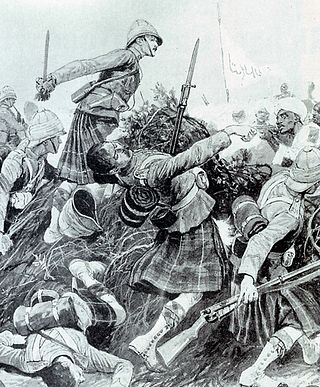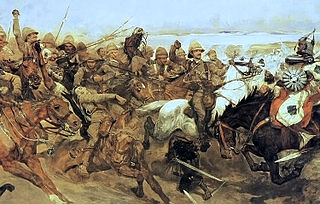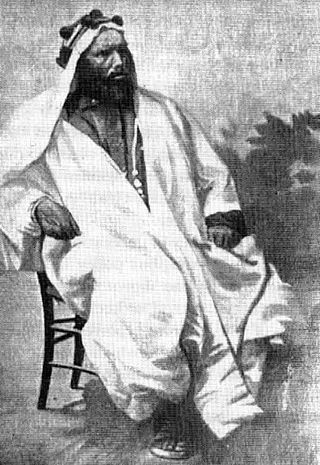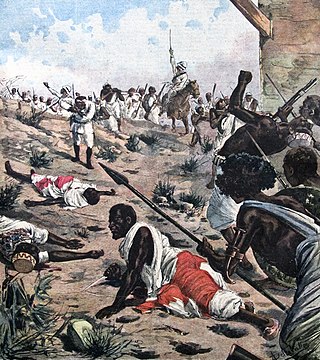
The First Italo-Ethiopian War also referred to as the First Italo-Abyssinian War; Italian: Guerra d'Abissinia, lit. Abyssinian War, was a war fought between Italy and Ethiopia from 1895 to 1896. It originated from the disputed Treaty of Wuchale, which the Italians claimed turned Ethiopia into an Italian protectorate. Full-scale war broke out in 1895, with Italian troops from Italian Eritrea achieving initial successes against Tigrayan warlords at Coatit, Senafe and Debra Ailà, until they were reinforced by a large Ethiopian army led by Emperor Menelik II. The Italian defeat came about after the Battle of Adwa, where the Ethiopian army dealt the heavily outnumbered Italian soldiers and Eritrean askaris a decisive blow and forced their retreat back into Eritrea. The war concluded with the Treaty of Addis Ababa. Because this was one of the first decisive victories by African forces over a European colonial power, this war became a preeminent symbol of pan-Africanism and secured Ethiopia's sovereignty until the Second Italo-Ethiopian War of 1935–36.

The Battle of Omdurman was fought during the Anglo-Egyptian conquest of Sudan between a British–Egyptian expeditionary force commanded by British Commander-in-Chief (sirdar) major general Horatio Herbert Kitchener and a Sudanese army of the Mahdist State, led by Abdallahi ibn Muhammad, the successor to the self-proclaimed Mahdi, Muhammad Ahmad. The battle took place on 2 September 1898, at Kerreri, 11 kilometres (6.8 mi) north of Omdurman in Sudan.

The Battle of Abu Klea, or the Battle of Abu Tulayh took place between 16 and 18 January 1885, at Abu Klea, Sudan, between the British Desert Column and Mahdist forces encamped near Abu Klea. The Desert Column, a force of approximately 1,400 soldiers, started from Korti, Sudan on 30 December 1884; the Desert Column's mission, in a joint effort titled "The Gordon Relief Expedition", was to march across the Bayuda Desert to the aid of General Charles George Gordon at Khartoum, Sudan, who was besieged there by Mahdist forces.

Agordat; also Akordat or Ak'ordat) is a city in Gash-Barka, Eritrea. It was the capital of the former Barka province, which was situated between the present-day Gash-Barka and Anseba regions.

The Battle of Atbara also known as the Battle of the Atbara River took place during the Mahdist War. Anglo-Egyptian forces defeated 15,000 Mahdists on the banks of the River Atbara. The battle proved to be the turning point in the reconquest of Sudan by the British and Egyptian coalition.

The Mahdist War was a war between the Mahdist Sudanese, led by Muhammad Ahmad bin Abdullah, who had proclaimed himself the "Mahdi" of Islam, and the forces of the Khedivate of Egypt, initially, and later the forces of Britain. Eighteen years of war resulted in the creation of Anglo-Egyptian Sudan (1899–1956), a de jure condominium of the British Empire and the Kingdom of Egypt in which Britain had de facto control over Sudan. The Sudanese launched several unsuccessful invasions of their neighbours, expanding the scale of the conflict to include not only Britain and Egypt but also the Italian Empire, the Congo Free State and the Ethiopian Empire.

Bahta Hagos, died December 19, 1894, was Dejazmach of Akkele Guzay, and retrospectively considered an important leader of Eritrean resistance to foreign domination specifically against northern Ethiopian and Italian colonialism. He was born sometime between 1839 and 1850 into a rich peasant family in the town of Segheneyti and was killed in the Battle of Halai against the Italian Colonial Army on December 19, 1894. He was of the Tsena-Degle Tigrinyas, from Akele Guzay.

The Royal Corps Of Eritrean Colonial Troops were indigenous soldiers from Eritrea, who were enrolled as askaris in the Royal Corps of Colonial Troops of the Royal Italian Army during the period 1889–1941.

The Battle of Kassala was fought on July 17, 1894, between an Italian colonial troop and Mahdist Sudanese forces.

Ras Alula Engida was an Ethiopian general and politician who successfully led Abyssinian battles against Ottoman Egypt, the Mahdists and Italy. He was one of the most important leaders of the Abyssinian forces during the 19th century. Described by Haggai Erlich as the "greatest leader whom Ethiopia produced since the death of Emperor Tewodros II in 1868." Ras Alula was referred to by Europeans as "the Garibaldi of Ethiopia".

The Second Battle of Agordat was fought in late December 1893, between Italian colonial troops and Mahdists from Sudan. Emir Ahmed Ali campaigned against the Italian forces in eastern Sudan and led about 10,000–12,000 men east from Kassala. This force encountered 2,400 Italians and their Eritrean askaris at Agordat, west of Asmara, commanded by Colonel Arimondi. Over 1,000 Dervishes, including the Emir, were killed in severe fighting. The outcome of the battle constituted "...the first decisive victory yet won by Europeans against the Sudanese revolutionaries,..."

The Battle of Halai, or the Battle of Halay, which took place in December 1894 was a battle between an Eritrean rebel force under Bahta Hagos and the Italian army.

The Battle of Serobeti took place on June 26, 1892 and was fought between Italy and the Mahdist State. The incident took place when one-thousand Mahdist warriors entered Italian Eritrea and were driven back by an Italian-led force of 120 ascari and 200 Baria tribe warriors. In all, Italian losses were three dead and ten wounded, while the Mahdists suffered around one-hundred killed and wounded. Author Sean McLachlan blames the Mahdists' "inferior weaponry and fire discipline" for their defeat at Serobeti and the preceding First Battle of Agordat (1890).

The Agordat class was a pair of torpedo cruisers built by the Italian Regia Marina in the late 1890s. The two ships, Agordat and Coatit, were armed with twelve 76 mm (3 in) guns and two 450 mm (17.7 in) torpedo tubes. They proved to be too slow and have too short a cruising radius to be of much use, so their service careers were limited. Their most significant action came during the Italo-Turkish War of 1911–1912, where both ships were employed in shore bombardment duties. Neither ship saw action in World War I. Coatit was converted into a minelayer in 1919 and sold for scrapping the following year, while Agordat was rearmed as a gunboat in 1921; she followed her sister to the breakers in 1923.
Events from the year 1890 in Italy.

The Battle of Agordat was fought near Agordat in Eritrea from 26 to 31 January 1941, by the Italian army and Royal Corps of Colonial Troops against British, Commonwealth and Indian forces, during the East African Campaign of the Second World War. The British had the advantage of breaking Italian codes and cyphers before the offensive and received copious amounts of information from Italian sources on the order of battle and plans of the Regia Aeronautica and the Italian army.

Giuseppe Edoardo Arimondi, OSML, OMS, OCI was an Italian general, mostly known for his role during the First Italo-Ethiopian War. He was one of the few European commanders who gained a victory over the Mahdists before Kitchener's Expedition, soundly defeating them at Agordat in 1893. After a long and successful colonial service, he died in combat at Adwa, and was posthumously awarded the Gold Medal of Military Valor.

The Italo-Ethiopian War of 1887–1889 was an undeclared war between the Kingdom of Italy and the Ethiopian Empire occurring during the Italian colonization of Eritrea. The conflict ended with a treaty of friendship, which delimited the border between Ethiopia and Italian Eritrea but contained clauses whose different interpretations led to another Italo-Ethiopian war.

Domenico Turitto was an Italian major who was part of the Royal Colonial Corps of Eritrea. He participated in the Mahdist War as he commanded the 1st Indigenous Infantry Battalion, occupying the city of Kassala and distinguishing himself at the Battle of Kassala. During the First Italo-Ethiopian War, Turitto commanded the vanguard of the Indigenous brigade under the command of Matteo Albertone before being killed in the battle. He was also a recipient of the Silver and Bronze Medals of Military Valor and a knight of the Order of Saints Maurice and Lazarus.

















